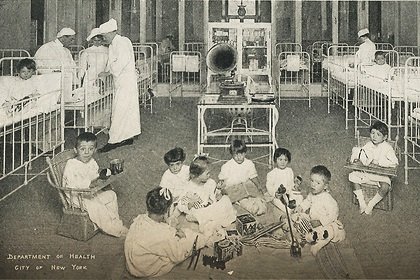Polio 1916: Putting the Pieces of Polio History Together
Shaded areas show localities involved in the poliomyelitis epidemic of 1916
In 2018 many noted the 100th anniversary of the deadly 1918 flu epidemic that killed 650,000 in the United States and perhaps 50 million world-wide. We should not forget, however, that two years earlier, in 1916, the United States experienced one of the most serious polio epidemics in the country. Centered in the northeastern states, and particularly in New York, the epidemic struck some 27,000 individuals, mostly children, and killed some 8,000. Pennsylvania had the third largest number of cases (2,181) after New York (13,223) and New Jersey (4,055).
There were 1,006 cases and 307 deaths in Philadelphia, which was the epicenter of the epidemic in the state. Cases were diagnosed across the state with Lancaster reporting 21, Wilkes-Barre 6, Hazelton 7, McKeesport 12, and Norristown 19.
Polio was a frightening new disease in the United States. It had been epidemic only since the 1894 epidemic in Rutland, Vermont. Doctors could diagnose the disease once paralysis appeared, but they could neither prevent it nor cure it. Doctors puzzled over the cause of the epidemic. They knew polio was caused by a virus, but not how it was transmitted from person to person. Many blamed the unsanitary living conditions in immigrant slums, but then how to explain why upper and middle class children in good neighborhoods came down with the disease. Perhaps flies carried the virus, and this theory inspired “screen the baby, swat the fly” campaigns.
Rutgers University Press, Polio Epidemic 1916
We now know that polio is spread through water or food contaminated by the fecal discharges of those sick with the disease. We also know that only 3-5% of infections result in paralysis. The other 95% of infections result in a mild or “unapparent” case of polio, but one capable of transmitting the disease through their stools. No wonder doctors couldn’t figure out what was happening or how to stop it.
Public health officials tried to stop the epidemic by quarantining victims either in their homes or in isolation hospitals. Immigrant children were often forcibly removed to hospitals over the strenuous objections of parents who feared hospitalization was a death sentence. Suburban communities around New York banned children from the city even as wealthy parents tried to flee the city with their children.
Little has been written about the 1916 epidemic in Pennsylvania. The epidemic in Philadelphia mirrored that in New York City, but on a smaller scale. Schools opened late that year, and doctors tried quarantine to halt the spread of the disease. In Pennsylvania and throughout the northeast the epidemic only receded with the onset of colder weather as the virus was most virulent in the hot days of summer and early fall. The epidemic spurred an increase in polio research, but it would be the late 1930s and 1940s before medical scientists began to understand how the virus was spread and to develop the techniques that led Jonas Salk and Albert Sabin to create their vaccines in the 1950s.
For those interested in the 1916 epidemic, I recommend Naomi Rogers, Dirt and Disease: Polio before FDR, a fine study of the history of polio in 1916 and the early twentieth century.





